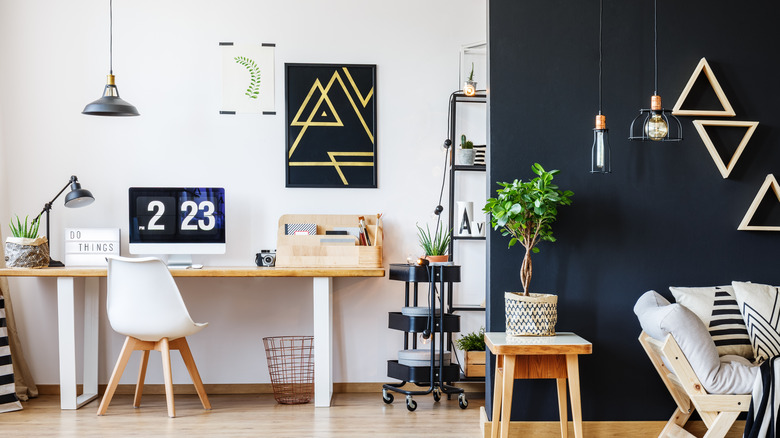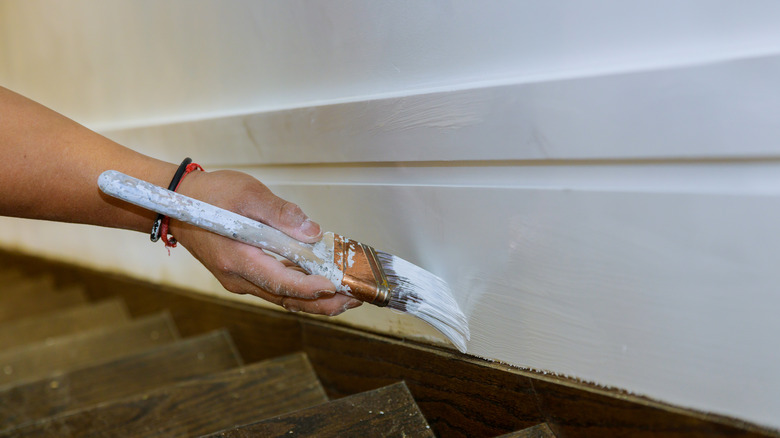4 Foolproof Tips For Painting With Dark Colors
Deciding what color to paint your room can be a little overwhelming, but it is equally exciting. Paint has the power to completely transform a room, make it feel brighter or more intimate, set a desired mood, increase productivity or rest, and more. Dark colors, in particular, are powerful at totally transforming the look and feel of a room.
There are a variety of benefits to painting rooms in your home a dark color. According to Mastercraft Painting & Finishes, dark paint is much easier to maintain than lighter colors, as collected dust, dirt, scrapes, and other natural wear and tear doesn't stand out as much. This makes it ideal for parents or pet owners. Dark paint can also create a very intimate atmosphere, making the room feel much more inviting and cozy. As a bonus, lighter color furniture and wall art will pop, creating a very modern and sophisticated sensibility. Dark paint is not the easiest to apply to your walls, though. Keep reading for some foolproof tips on how to paint your walls a dark color.
1. Thoroughly prepare your walls
The key to ensuring a flawless finish for any paint job is to thoroughly prepare your walls, but the same is even more true for darker paint colors. While lighter paint shows more flaws when dry, it is also a lot easier to touch it up once you're done. As Zenith Painting & Coatings notes, darker paint is not nearly as forgiving when it comes to touch-ups. That's why it's important to get it done right on the first go.
To prepare your walls for painting, you should first thoroughly wash them and remove any dirt, grime, dust, etc. (per Sherwin-Williams). Next, sand them down to ensure there aren't any uneven textures shining through the final product. One of the most important aspects of preparing walls for dark paint is making sure you adequately tape up the borders, as leaking dark paint will be very difficult to remove. Use a good quality painter's tape, and use a putty knife to press it into the wall. Also, ensure you use a good primer, as darker paint colors have a tendency to get sucked into the porous wall and look uneven.
2. Buy more paint than you think you need
While many people believe darker paints will easily apply over light colors, that couldn't be farther from the truth. As Southern Painting notes, dark paints have less body or base than light colors, which means it's more translucent when applied. This means you'll not only need to thoroughly prime your walls, but you'll probably need to apply at least two coats, but likely more. This can be affected by the efficacy of your primer, the finish of your paint, and more, though.
For this reason, you should probably buy more paint than you think you need. Running out of paint in the middle of your project will not only be annoying, but it can ruin the final look of your paint. Your paint's wicking rate will affect the final outcome — the moisture in your paint will evaporate at different rates during different applications, which can create mild to major tone differences when dry (via Sherwin-Williams). Even if you buy the same exact paint color, applying it on a different day can create an unseemly color difference. Avoid this by buying more paint than you think you'll need. Luckily, most hardware stores will let you return unopened paint cans.
3. Start simple with an accent wall
As explained earlier, dark paint is a lot harder to cover up or change once applied. If you're interested in introducing dark paint into your home, but aren't completely sure, start slowly with an accent wall. Accent walls are one wall in your home that is painted a different color from the rest, with the intention of adding a fun pop of color, visual difference, or drawing attention to furniture or wall art, per Diversified Painting.
Accent walls are also a great way to introduce a big change in a small way. If you paint one wall in your home a dark color and don't like it, it's much easier to cover that one area than a whole room. On the flip side, if you do like it, you've saved yourself the hassle of one wall. If you have a small room that you want to paint dark, but you're worried it'll look too cramped, you can add your desired dark paint color through an accent wall.
4. Paint your cabinets, doors, and trim
If the hassle and permanence of dark paint is too intimidating for you, but you still want to incorporate darker tones into your home, consider painting something other than the walls. Window and door trims, cabinets, doors, and other architectural features both inside and outside of your home can be painted dark to stand out.
As The Moulding Company points out, the wall trim inside your home presents a great opportunity to add some flare and uniqueness, especially when contrasting light floors or wall paint with dark trim. You can go with a simple black, go a few shades deeper than your current wall color, or go for a completely new dark shade. The same can be said for window and door trims. Painting trim also requires a lot less labor and materials than whole walls.
You can also spring for a slightly bigger project by painting your kitchen or bathroom cabinets a dark color. According to NHance, dark cabinets provide lots of contrast with lighter countertops or hardware, as well as providing a luxurious, elegant look.




